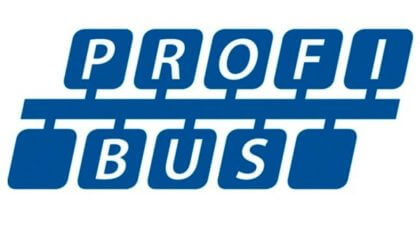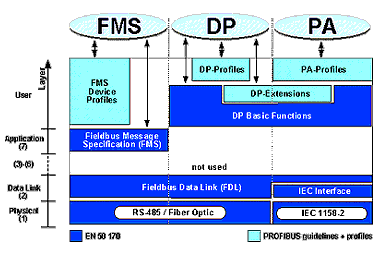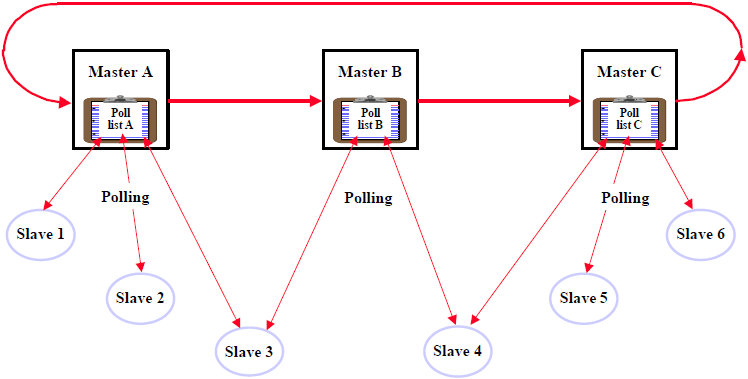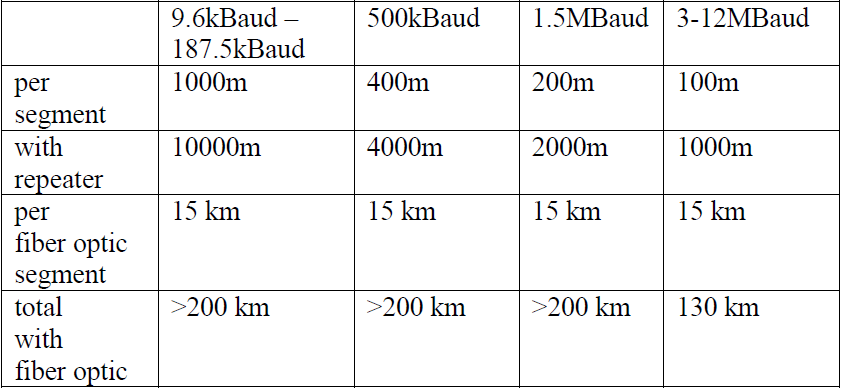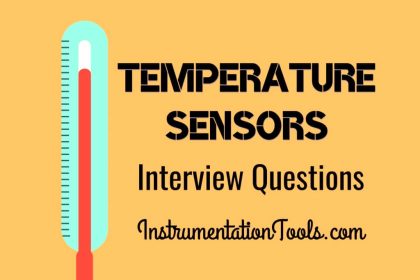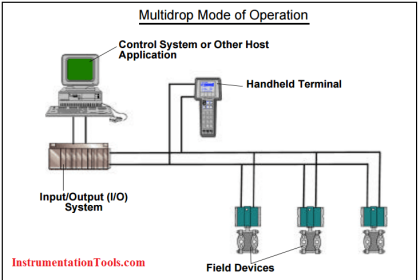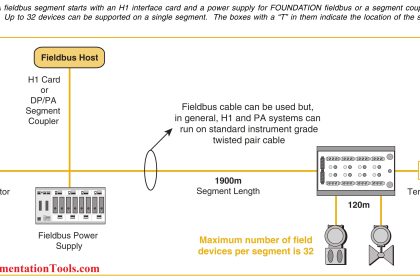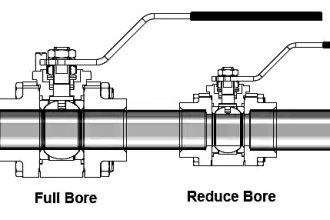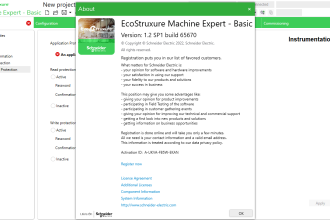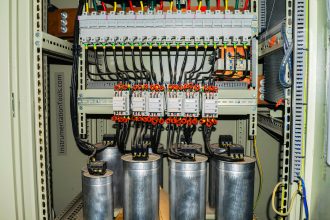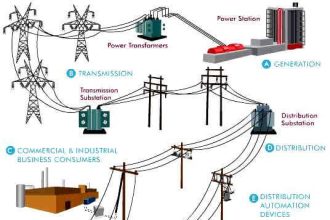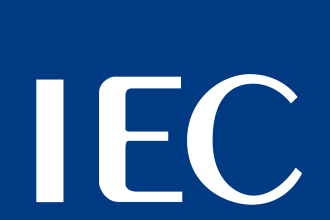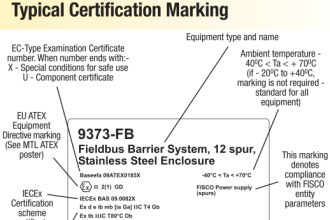Read the frequently asked Profibus Communication Interview Questions & Answers useful for Automation Engineers, PLC Engineers, DCS Engineers.
Profibus Communication Questions
What is PI ?
PI was formerly know as PROFIBUS International. It is the umbrella organization responsible for the PROFIBUS protocol and its promotion and support across the world via a network of Regional PI Associations.
When PROFINET, PI’s Industrial Ethernet solution, was launched, PROFIBUS International was re-named ‘PI’ (PROFIBUS and PROFINET International).
How do we terminate the shielding of the profibus cable ?
It is recommended to connect the shield on both ends low inductively to ‘ground’ in order to achieve optimal electromagnetic compatibility. In the case of separate potentials (e.g. in a refinery) the shield should be connected only on one end of the cable to ‘ground’.
Preferably, the connection between shield and protective ground should be made via the metal cases and the screw top of a D-sub connector. If this is not possible the connection can be made via pin 1 of the D-sub connector. It should be noticed that this is not the optimal solution.
In such a case it is better to bare the cable shield at an appropriate point and to ground it with a cable as short as possible to the metallic structure of the cabinet. This can be done with a ground bus bar in front of the bus connector.
What is PROFIBUS-DP ?
This is the performance optimized version of PROFIBUS, specifically dedicated to time-critical communication between automation systems and distributed peripherals.
It is suitable as a replacement for the costly parallel wiring of 24 V and 4(0) to 20 mA measurement signals. PROFIBUS-DP is included into the European Fieldbus Standard EN 50170.
ident numbers: what are they, where do I get them?
Every DP/PA device type has to have an individual ident Number. This number is necessary so that a DP-master is able to identify the types of the connected DP/PA devices without a significant protocol overhead. The master compares the ident Number of each connected device with the ident Number in the configuration database.
User data transfer in the operation phase is only possible when the right DP Slave is connected to the correct address. This ensures very high protection against parameterization faults. The vendors must apply to the PPROFIBUS Support Center for an individual ident Number for every DP/PA device type.
What is PROFIBUS PA?
PROFIBUS-PA is a ‘profile’ of PROFIBUS designed specifically for use in process automation for connecting control systems with field instruments. PROFIBUS-PA is based on PROFIBUS-DP and, using a linking device called a segment coupler, permits transparent communication between general purpose automation and process automation networks, making PROFIBUS ideal for hybrid applications where factory and process devices intermingle.
The PROFIBUS PA profile defines the behavior of the field devices and ensures full interoperability and interchangeability between different manufacturers. PROFIBUS PA operates either with Intrinsically Safe transmission technology (acc. to IEC 61158-2) or standard transmission technology (acc. to RS485).
In summary, PROFIBUS PA fulfills the special requirements of all sectors of the process industry as follows:
- transparent communication between process automation networks and general purpose automation networks is possible.
- PROFIBUS PA permits powering of the field instruments and data transmission over the same two wires.
- PROFIBUS PA can be used in potentially explosive atmospheres using Intrinsically Safe transmission technology according to IEC 61158-2.
Explain about Profibus Protocol Architecture ?
PROFIBUS is based on recognized international standards. The protocol architecture is oriented to the OSI (Open System Interconnection) reference model in accordance with the international standard SO 7498.
In this model every transmission layer handles precisely defined tasks. Layer 1 (physical layer) defines the physical transmission characteristics. Layer 2 (data link layer) defines the bus access protocol. Layer 7 (application layer) defines the application functions.
The architecture of the PROFIBUS protocol is shown in figure.
PROFIBUS-DP
PROFIBUS-DP uses layers 1 and 2, and the user interface. Layers 3 to 7 are not defined. This streamlined architecture ensures fast and efficient data transmission. The Direct Data Link Mapper (DDLM) provides the user interface easy access to layer 2.
The application functions which are available to the user as well as the system and device behavior of the various PROFIBUS-DP device types are specified in the user interface. RS 485 transmission technology or fiber optics are available for transmission.
PROFIBUS-FMS
In PROFIBUS-FMS, layers 1, 2 and 7 are defined. The application layer consists of FMS (Fieldbus Message Specification) and LLI (Lower Layer Interface).
FMS contains the application protocol and provides the user with a wide selection of powerful communication services. LLI implements the various communication relationships and provides FMS with device-independent access to layer 2.
Layer 2 (FDL, Fieldbus Data Link) implements bus access control and data security. RS 485 transmission technology or fiber optics are available for transmission for PROFIBUS-FMS.
PROFIBUS-PA
PROFIBUS-PA uses the extended PROFIBUS-DP protocol for data transmission. In addition, the PA profile, which defines behavior of the field devices, is used.
Transmission technology, in accordance with IEC 1158-2, permits intrinsic safety and also allows the field devices to be powered over the bus. PROFIBUS-PA devices can be easily integrated in PROFIBUS-DP networks using segment couplers or Links.
PROFIBUS-DP and PROFIBUS-FMS
PROFIBUS-DP and PROFIBUS-FMS use the same transmission technology and a uniform bus access protocol. Thus, both versions can be operated simultaneously on the same cable.
What are the basic configurations in PROFIBUS Communication protocol for interfacing PLC, HMI, Field Instruments?
Profibus or process field bus is digital industrial communication system that use physical mediums such as optical fiber or copper cable for data exchange.
Profibus is classified into the following categories.
1. Profibus FMS
2. Profibus DP
3. Profibus PA
4. Profi-Drive
5. Profi-Safe
Profibus FMS
Profibus FMS (field messaging system) is an obsolete now. Honestly i don’t know much about it.
Profibus DP
Profibus DP (Decentralized Peripheral ) is used for interfacing PLC’s, Remote IO Systems, Variable Frequency Drives, HMI’s, Encoders, Sensors, Actuators and other similar devices. It uses RS 485 technology . As of now DP V-2 is the latest version.
Profibus PA
Profibus PA (Process Automation) is used for interfacing field measuring devices such as flow transmitters, pressure transmitters etc. It uses Manchester Coding technology.
Profi-Drive
Profi-Drive is used for motion control applications (Controlling of Servo motors in position control mode).
Profi-Safe
Profi-Safe is used for Fail Safe applications.
Hamming distance (HD): what does it mean?
The hamming distance is a measure for how secure a protocol is against misinterpretation of a packet.
HD=4 tells us that at least 4 bits have to be wrong, yet still match the checksum calculations, in order for it to be mistaken as a valid packet.
Why are terminators important?
Termination of the bus prevents signal reflections on the PROFIBUS cable. Wrong or missing termination results in transmission errors when the worst case result is that the communication link is lost.
In addition, the PROFIBUS termination provides a defined ‘idle’ level for the cable.
What is a profile? Which are available?
Profiles are definitions of non-mandatory services and parameters for specific areas of applications.
It helps to minimize the implementation efforts to implement PROFIBUS functionality in appropriate field devices.
What are the main advantages of PROFIBUS over other fieldbus types?
This is a subjective issue but – provided that the technical solution is satisfactory for the task – it boils down to cost/benefit comparisons.
PROFIBUS provides users with the best possible, future proof bus system that can cope with the broad needs of factory and process automation. Market acceptance and sheer momentum means that PROFIBUS is a de-facto fieldbus standard throughout the world.
Here are some of the facts:
- PROFIBUS has the largest portfolio of products in the fieldbus world. In 2008 it reached 2400 products and services.
- It has the largest installed base. At the end of 2008 the total had passed 28 million and by 2012 it is expected to reach 50 million.
- It is supported by the largest user organization in this industry. PI had over 1400 members at the end of 2008.
- There are 24 Regional PI Associations worldwide, ensuring local support in all industrialized areas.
- There are close to 400 vendors of PROFIBUS products and services, hence there is plenty of choice for users.
- It’s supported by manufacturers of both master and slave devices providing a truly open approach and practical vendor independence.
- Choice drives competition amongst vendors, leading to cost, supply and performance benefits for end users..
- PROFIBUS technology can be used for several levels within the information flow in a company.
- Knowledge of one standard can be utilized on several levels.
- There’s wide application potential across factory, process and building automation.
- It’s a stable protocol with many chip options available today.
- It’s suitable for operation in intrinsically safe areas in process control.
- It is the only fieldbus that can be used in hybrid applications – where process and discrete automation segments co-exist in a plant.
- Platform independence means PC, PLC and DCS based controllers are available.
- 244 byte telegram means that large packets of data can be sent without segmentation.
- > 100km distance is achievable using fiber optics.
Also Read: HART Communication Interview Questions & Answers
Why are Class 1 and Class 2 masters different?
A Class 1 master can communicate actively only with its configured slaves and is able to communicate in a passive way with a Class 2 master. The class 2 master is the ‘supervisory’ device.
It can communicate with Class 1 masters, their slaves and its own slaves for configuration, diagnostic and data/parameter exchange purposes.
What is a failsafe mode? What does a failsafe mode mean?
This mode defines the status of signals in IO modules if a bus or system failure occurs. It is common that all output signals are going to the zero voltage level in a fail safe situation.
The status is important in functional safety applications where a profile such as PROFIsafe is used.
Why is no signal ground/reference wire used in PROFIBUS cables?
To ensure easy handling a signal ‘ground’ wire is not used by PROFIBUS.
However, it is recommended to isolate the interface circuit from the local ground (e.g. using opto-couplers) to reduce possible common mode voltages between transceivers.
Is PROFIBUS an open or proprietary system?
PROFIBUS is completely open. It was originally standardized in Germany in 1989 as DIN 19245 and in July 1996 as EN 50 170.
The EN 50 170 specification is available through any of the national standards bodies of CENELEC / IEC and the PROFIBUS Specification can be supplied by any of the Regional PROFIBUS Associations. It’s now globally standardized under IEC 61158.
Is it possible to calculate a cost per device for a PROFIBUS System?
Not generally but PROFIBUS connectivity should not add significantly to standard field device costs as most devices today are digitally based anyway. It’s more instructive to look at wider issues.
Having a single cable to connect devices means big savings in design, engineering and installation costs. Furthermore, the availability of data across the plant means even more savings are possible over the lifetime of a device through better operations and improved asset management.
Better data flows lead to better plant management too. Overall, any extra cost per device is insignificant compared with the life cycle savings of a fieldbus network.
What is a GSD file ?
A GSD file is used to identify the basic operational characteristics of a PROFIBUS device, to aid interoperability and interchangeability.
It makes it possible to have manufacturer-independent configuration tools. Typically, a GSD file includes vendor information, baudrates, timing information, the options or features supported and the available I/O signals.
A GSD file must be available for every PROFIBUS slave.
What are the roots of PROFIBUS?
The base of the specification of the PROFIBUS standard was a research project that took place between 1987-1990, supported by the following companies: ABB, Phoenix Contact, AEG, Rheinmetall, Bosch, RMP, Honeywell, Sauter-Cumulus, Kloeckner-Moeller, Schleicher, Landis & Gyr, Siemens.
Five German research institutes also cupported the project: FZI Karlsruhe, LRT, IITB, WZL, LPR
There was also minor sponsorship from the German government.
The result of the project was the first draft of DIN 19245, the PROFIBUS standard.
What if my PROFIBUS system should fail, or a chip fail in a device?
PROFIBUS has been designed to allow configurations where redundant cabling is possible to take account of wire breaks. Also, node failures can be configured to be ignored, or to trigger a ‘stop’ in the master.
In this case unaffected nodes can continue operation. When a failure is identified the master immediately resends the telegram and it’s possible to configure the number of times this is attempted.
Information relating to the failure is generally available on a node, a module within a node and on a channel specific basis.
Certification testing of devices through an authorized test laboratory ensures that potential failures conform to what is expected of them. Media redundancy can be achieved through dual master systems.
Can new devices be added to a PROFIBUS system without upgrading the system?
PROFIBUS guarantees backwards compatibility. So, if new functions are offered in a device it will still be possible to use this device on the same wire with older devices, allowing progression of the system without forcing users to upgrade unless they specifically wish to enhance their functionality.
What hardware and software is needed to set up a PROFIBUS system?
In addition to a PLC and the devices to be controlled
- a cable – Shielded Twisted Pair with terminating resistors or Fibre Optic with Optical Link Modules
- a GSD file for each device (A simple ASCII text file containing device data like identification info, what transmission speeds are supported, data format, time required to respond etc.)
- a software configuration tool. This configures the active stations and tells them what devices are present on the bus and how much data it needs to exchange with them etc. is required.
What connectors, pinout and mandatory signals are used?
The PROFIBUS Standard does not specify an alternative to the 9 pin D-SUB connectors, but it is often necessary to have alternatives available.
The test specification for DP Slaves defines:
- Alternative connectors may be used. No special connector is defined. But if the device with these alternative connectors should be certified, it must have all the mandatory signals of the PROFIBUS D-SUB connector available.
- Furthermore, you should take into consideration for high speed usage, that some additional components should be used in combination with the D-SUB connector, or any other one.
- These components (R, L, C) are specified into the Implementation Guideline for PROFIBUS-DP, and are explained in detail including sample circuit diagrams in the new PROFIBUS-DP book (The Rapid Way to PROFIBUS-DP). This book may be ordered from your local PROFIBUS organization.
Are there any particular applications or sectors of industry that particularly benefit from PROFIBUS?
PROFIBUS has already found many applications in factory, process and building automation, for example from Automotive manufacture at General Motors across Europe, to Breweries like Bitburger and Guinness to building management like the Russian Kremlin building.
PROFIBUS is also being used in applications that were never envisaged from its conception, because it has been constructed in a way that allows for many new device types to be added.
However, the two key areas of industry that can most benefit from its adoption are :
- Factory Automation, where signal wiring costs are cut significantly and many devices can be installed directly on the bus, thus removing the need for many input and output signals.
- Process Automation, where cabling costs are significantly reduced; devices can be placed directly in the hazardous areas; many analogue I/O cards can be eliminated by transferring all data on one twisted pair cable. This also reduces the need for I/S barriers.
Profibus Cable specifications: What should I use?
The PROFIBUS standard defines two variations of the bus cable. However it is recommended to use cable Type A in all new installations.
Type A is recommended for high transmission speeds and permits a doubling of the network distance in comparison to Type B.
Type A Technical specification:
- Impedance: 35 up to 165 Ohm at frequencies from 3 to 20 Mhz.
- Cable capacity: < 30 pF per meter.
- Core diameter: > 0,34 mm², corresponds to AWG 22.
- Cable type: twisted pair cable. 1×2 or 2×2 or 1×4 lines.
- Resistance: < 110 Ohm per km.
- Signal attenuation: max. 9 dB over total length of line section.
- Shielding: CU shielding braid or shielding braid and shielding foil.
- Max. Bus length: 200 m at 1500 kbit/s, up to 1,2 km at 93,75 kbit/s. Extendable by repeaters.
What is PROFIBUS ?
Profibus is a building automation communications standard which defines application layer data and physical connections.
PROFIBUS (PROcess FIeldBUS) Is An industrial control network used for factory automation, process control, motion control and safety networks. Using a master/slave architecture, specialized “Profiles” are used to support each of these areas. Several messaging could be added over PROFIBUS:
- Profibus DP
- Profibus S7
- Profibus S5
- Profibus MPI
What is Profibus Dp
PROFIBUS DP (Decentralized Peripherals) is used to operate sensors, actuators and input/ output deported via a centralized controller.
On a PROFIBUS DP network, 126 equipments could be connected. Each equipment could support up to 244 input/outputs. PROFIBUS DP is a fast protocol.
The communication can be established up to 12M Bauds. PROFIBUS DP is deterministic due to its timing configuration (cyclic communication). Acyclic requests are also possible.
What is Profibus PA
PROFIBUS PA (Process Automation) is used to monitor measuring equipment via a process control. PA has a data transmission rate of 31.25 kbit/s.
However, PA uses the same protocol as DP, and can be linked to a DP network using a coupler device (Gateway/link).
PROFIBUS PA could be used in intrinsically safe and non intrinsically safe sector. It provides a solution to provide power via the bus.
What is Profibus DPV1
Profibus DPV1 is used to read or write some record memory bloc (via slot, index). Several profiles normalized these records (area memory). DPV1 is based on two modes: Class 1 and Class2. DPV1 is based on top of DPV0
What is DPV0/DPV1 Class1 and Class2
With Profibus DPV0 and DPV1, two communications types are available:
- Class1 is defined when the device belongs to a master (connection established/ cyclic IO data exchanged).
- Class2 is used to communicate with a device without establishing an IO connection. In case of DPV1, since there is no established connection, a specific connection (initiate request) is established.
What is FDT/DTM
FDT/DTM standardizes the communication and configuration interface between all field devices and host systems. Any devices can be configured, operated, and maintained through this standardized user interface regardless of supplier, type or communication protocol.
The FDT/DTM describes interface that standardized data exchange between devices and control system or engineering or asset management tools.
Elements in FDT/DTM architecture are:
- FDT Frame : This element is a container that allow to embed DTMs. FDT Frame offer services like user management, project management and services that allow communication between DTMs.
- DTMs : DTMs are classified into two categories :
- 1. Comm DTMs: Represents communication components like PC communication cards, couplers, gateways, remote I/Os, and linking devices.
- 2. Device DTMs which connect to the field device configuration components (e.g: Profibus: DP, DPV1, PA device). DTM is provided by the device manufacturer and represents the whole logic and parameters of a device.
What is Profiles
Several profiles are available for Profibus DP (profisafe, profidrive). This profile defines the memory mapping of each record memory.
A profile defines a common interface that allows changing a device compliant to a profile by a device from a competitor supporting the same profile, with no change required on the PLC program.
What is Freeze and Sync
The freeze command is used to freeze the slave inputs, the sync command is used to synchronize the slave outputs. The group must be defined during the configuration. This feature uses a broadcast telegram (global control).
The slave_diag command can be used to know if the freeze or sync modes are enabled or not.
What is SetSlaveAddress Command
The set slave address command provides a mechanism to set a Profibus station address to a slave. This feature can be used to replace a slave by another without manual configuration.
This address can be stored in permanent mode or volatile mode by the slave.
What is S7/S5 MPI
S7 is a messaging allowing to communicate with all SIMATIC S7 PLC. This messaging is offered on TCP/IP and PROFIBUS. The molex product supports this messaging on several products (Ethernet, profibus).
Through Profibus S7, several distinct memory area are accessible (write or read) MEMEMTO, DB, TIMER, COUNTER,… Different kinds of connections are possible: CPU socket via MPI and S7 COMMUNICATION COUPLER via Profibus S7.
The range of SIEMENS PLC supporting this protocol is wide. This messaging is based on the Client/Serveur model. A Server can accept several connections. The applicom Products support all S7 equipments (S7-200, S7-300, S7-400 and S7-1200).
The messaging S5 is similar to S7 messaging but dedicated to SIMATIC S5 PLC.
What Bus type does your system implement. Examples CMSA/BA, CMSA/CD, master/slave, multiple masters etc.?
PROFIBUS is based on a Token principle with underlying Master/ Slave communication (hybrid media access).
Services:
- SDN-Send Data with no acknowledge (can be used for multicast/broadcast)
- SDA- Send Data with acknowledge
- SRD- Send and Reply with Data (for efficient bi-directional data transfer)
What is the maximum number of nodes that the network can support?
PROFIBUS allows up to 32 nodes per segment and up to 126 nodes for one network.
What is the Bus topology?
The base technology is a line which allows connection and removal of nodes at any time without breakdown.
PROFBUS allows ring and star topology as well with fiber optics.
What is the maximum transmission distance without repeaters. What baud rate is supported at this maximum distance ?
The maximum distance would be 1000m by using copper with baudrates between 9.6 – 187.5 kBaud.
The maximum length may be extended with fiber optic links (up to 2300/15000 m per link)
What types of transmission media are used and supported ?
- Copper cable (shielded twisted pair- known as IBM type 1 cable)
- solid and stranded cable
- specialized materials for plastic surrounding
- fiber optic
- in glass
- in plastic
- Infrared
How many bits are allocated at a node for input and output data ?
PROFIBUS allows between 0 and 244 byte, determined by the device requirements for input and output each.
How is the bus powered ?
There is no specialized bus power supply. The terminal resistors with pullup and pulldown are located at the end of the line and powered be the devices on that place. One combination is enough to run the system.
If the bus provides power to field devices what current level is available ?
PROFIBUS PA does supply power for intrinsic safe devices connected with twisted pair. This is done according to IEC 1158-2 specification (maximum current is 120 mA per coupler for intrinsic safe operation and >300mA for non intrinsic safe operation).
How are node addresses set ?
Two methods are supported:
- DIP switches or similar techniques
- setting of the node address via the bus connection
Any choice is possible
Does the bus provide duplicate address detection ?
Configuration checks for duplicate addresses.
Masters will look for duplicate addresses before entering the token ring and when unexpected frames are received.
Slave must be set up with their ident-number and with their configuration. In case of a mismatch, this will be reported to the masters application.
Does the bus provide an address attendance check after the first scan ?
- through a so called live list
- scanning of configured slaves is done cyclic
- scanning for new masters is executed all time
Does the bus provide a node configuration check after the first scan ?
Yes, with the function config_check after power up. In addition, the ident number is also checked.
Does the bus provide error detection and correction algorithms ?
PROFIBUS has a variety of error detection capabilities
- Checkbits in every byte
- Checksum for every message
- Startdelimiters for efficient frame detection
- Addressing information (source and destination)
- Inactivity detection to find out the beginning
- Transmitter check at the master devices
- Monitoring the token passing procedures
- The error correction is done by retries.
- PROFIBUS includes message duplication capabilities
Can a node provide parameter programming. Examples logic inversion and similar Boolean operations. Explain any extended detection ?
There are several ways for parameter setup:
- PROFIBUS allows the individual set of parameters (a maximum of 237 Bytes) during the startup
- Acyclic exchange of parameters at runtime.
- Parameter load from a PC by a second master
What I/O granularity does the Bus support ?
- The minimum is one byte
- The granularity is determined by the device
- Integer, unsigned, floating point, string and structures of the base types are possible.
- A node may have IO-modules with the granularity of one bit.
- There are various links available connecting subordinated bit-level busses (i.e. AS-I)
What minimum address space allocation does the bus provide ?
This is determined by the device, the minimum would be one byte.
What is the protocol efficiency of this Bus ?
The protocol efficiency may be up to 70%.
The configurations mentioned in the performance metrics section have a efficiency of 40%. This figures are configuration dependent.
Does the Bus support multiple protocols ?
- PROFIBUS FMS,
- DP
DP extensions may use the same link and may be implemented in one node
What diagnostic systems are in place to verify proper drop and node connections ?
Several diagnostic tools are available which allow to measure the bus and connectors for proper installation.
A simple electric meter will do it for most cases (a segment unpowered has a resistance of 110 to 130 Ohms for mid range cable length).
Can the Bus be enabled in segments to minimize troubleshooting requirements ?
- Segmenting can be done by use of repeaters or optical link modules.
- Step-by-Step start up can be done through the connectors by using the integrated termination.
What high level tools are available for network diagnostics ?
Every PROFIBUS Master allows detailed diagnostic function within the application
- Diagnostic information of each individual slave(Type of Slave, availability, various status information)
- Diagnostic overview of all slaves
- Master Diagnostic information
- Statistic counter
- Service engineers can use a bus monitor which allows to trace the bus.
- Monitoring all data
- Hardware filtering mechanism
- Time stamps
- Trigger conditions
- Special events
Can a network configuration be restored remotely ?
Network download protocol is defined in the standard
Some System have proprietary protocols to prevent inconsistencies (network configuration and PLC configuration are NOT independent)
Does the Bus provide tools for throughput monitoring enabling the user to check the validity of various node configurations ?
Various configuration tools offer such a functionality as well the bus monitor.
Most users look on reaction time rather than cycle time which includes the PLC scan.
Does the bus support any kind of hot swap capability ?
PROFIBUS allows replacing of devices without interrupting the bus traffic to connected nodes.
Slave devices need not be reconfigured in case of a switching in the masters role.
How long would it take to update a network with 16 nodes of 256 digital I/O (4096 total points) ?
- 1.09ms by 12MBaud
- 6,71ms by 1.5MBaud.
What is the best and worst case repeatability of this configuration ?
The best case which is 99% the normal case is that the timing is absolute stable (5% jitter is possible due to control functions)
In case of a failure (stations are dropping out) the timing can change
1 transmission failure will be corrected within 500/100μs (1,5/12Mbaud)
1 station failure will add a jitter of 700/300μs
A worst case scenario of 33ms by 1.5MBaud or 6.6ms by 12MBaud for one cycle will occur when all stations fail (in this situation the reactiontime is meaningless).
After the failure detection the timing is back to the regular cycle time.
How long would it require to update a network with 256 analog I/O points.(16 bit words) ?
It is exactly the same time as under 1., PROFIBUS makes no difference in the format. 256 words is equal to 4096 I/O points. I’m assuming that we have 256 words in each direction, 256 input words and 256 output words.
A difference can occur in your master station. The PLC or PC might make a difference in calculating I/O or analog values. PROFIBUS makes no difference.
How well will this implementation scale with respect to improvements in raw bit rate transmission ?
There is a transmission speed detection in almost every slave device as well as repeaters. This will enable the user to change the Baudrate by simply changing it at the masters site.
PROFIBUS has enhanced transmission speed 2 times. there is no problem with the various devices because all functions may run at a basic configuration.
Can portions of the network be scanned more frequently than the entire system ?
A change of the cyclic list is possible, however due to the fast cycle it is not necessary in typical applications. There is a possibility to send low frequent cyclic messages as acyclic messages.
Is message prioritization implemented ?
PROFIBUS defines 2 message priorities, an application prioritization is only possible within FMS.
Can larger consecutive blocks of data be moved using block transfer ?
Yes, with all protocols.
What attributes of you system qualify as a best in class ?
Deterministic, speed, ease to use, acceptance, support, diagnostic, multi protocols.
PROFIBUS offers a great flexibility. This enables the application engineer to make his design without counting bits and bytes. One byte more is less than 1μs! Error recovery will be done quickly without user interaction.
It easy to integrate PROFIBUS in field devices.
PROFIBUS is a very robust protocol with outstanding error handling capabilities.
PROFIBUS-DP allow transmission of IO-Data with short reaction time this include transportation from IO to the bus and from the bus to the application.
PROFIBUS-DP can be configured without specific communication knowledge. The device model is exactly what matters in remote IO.
PROFIBUS DP is what the user needs mostly.
What happens if the PROFIBUS cable has a short-circuit?
A short-circuit at the PROFIBUS cable can disturb a data communication in the particular segment. The devices in that area will NOT get damaged!
The short-circuit can easily be detected with an oscilloscope and even the distance to the problem can be masured. If the end-user wants to keep the installation running during a short-circuit he can pick the following solutions:
- Install a redundant system.
- Divide the installation in multiple parallel segments coupled by repeaters, OLMs or ProfiHubs and ComBricks.
- Install the cable in separate cable trays.
Why are termination problems the most common fault?
A lot of people are aware that termination has to be powered and activated at both ends of the cable. What they do not know, is that it has to be activated again when you are using repeaters, OLMs or Profihubs.
Every segment has to be terminated! This often slips in when people are using lots of fibre optic and there is only a short length of copper cable in the cabinets. Even this short cable has to be terminated at both ends.
Will the PROFIBUS plugs with diagnostic LEDs have influence on the busload?
The input resistance of the diagnostic plugs is approx. 1,5..2,0 M Ohm (analog comparator input). This is 100 times higher as the RS 485 receiver input impedance. In theory this should not cause any problems which have not been detected so far.
How many PROFIBUS DP repeaters can be installed in series?
There are lots of stories out there concerning this subject. The actual answer lies in the electronic components of the repeater. These determine the actual “maximum number?
The digitalization from and to the opto-couplers in the repeater will make bits smaller or wider. If you put too many repeaters in series, the bits differentiate too much and messages are not recognized anymore. There are also repeaters available with no limit in serial placement.
Check the manual of the repeater! It should state the maximum amount. For example: the Siemens repeater is 9, the ProfiHub is unlimited.
The second step is changing the busparameters. All repeaters have a delay time. If you put a large quantity of repeaters in series you might have to change the Tslot busparameter to a higher value.
Why is termination important?
Termination prevents reflections that can disturb the data communication. The higher the baudrate and the longer the cable, the more important termination becomes.
Termination should be activated/placed at both ends of every bus segment. With PROFIBUS DP the termination is powered to provide an idle level when nobody is sending data.
With PROFIBUS PA the termination is a combination of a resistor and a capacitor.
Should there be distance between PROFIBUS and power cables?
YES, even PROFIBUS can get disturbed by interference caused by parallel high voltage power lines. Always try to have at least 10 cm air space between the cables (depends on the level of the voltage).
Most users mix all cables in one cable tray and that often leads to unreliable behavior. Cables that cross each other will not cause problems. Creating distance is not the only requirement. Correct shielding is also a must!
Can you give some basic tips for installing a PROFIBUS DP network?
- Always use PROFIBUS cable and connectors.
- Do not exceed 32 devices per segment (including repeaters, OLMs and couplers).
- Make sure the segment length is in contrast with the baudrate.
- Make sure every segment has powered termination on both ends.
- Avoid spur lines.
- Avoid swapping the wires (A=green, B=red).
- Mark how long the cables really are and update the drawings.
After installation you should test your work:
- Are the addresses correctly set?
- No short circuit or break in the cable?
- Can you communicate with the devices?
Can I install PROFIBUS DP cable in a PA network?
Lots of users have the impression this will never cause a problem because of the high speed signal characteristics of DP cable (even if the impedance is not correct), but there are other factors that could make it very unstable
- There will be too much voltage loss at the end of the cable because of the higher loop resistance of standard DP cable (110 Ohm/km). PA cable has a loop resistance of 44 Ohm/km. When it is an Ex coupler with only 12.xV output, there is a change the last devices “get lost” all the time”.
- The DP cable gets over-powered because of its “thin” 0.64 mm diameter wires. PA cable wires have a diameter between 0.8 to 1.5 mm.
- PA Coupling components cannot handle the “thin” wires of the DP cable.
- When it is an Ex installation, the DP cable is probably not blue and not suitable for the FISCO Ex specs.
Our advice is to use only cable that complies with the PA specifications!
What is the minimum distance between 2 devices on PROFIBUS DP?
When the transmission speed is 1,5 Mbps or higher, it is highly recommended to have at least 1 m of cable between 2 devices. De input capacitance of both devices will be compensated by the cable in order to preserve the common impedance.
When the devices would be very close together, there is a big chance the input capacitance causes reflections in the data communication (small short circuits). The effect is much less at transmission speeds lower than 1,5 Mbps.
Does PROFIBUS DP cable always have a violet colour?
NO, because of certain application, protection and isolation classes, PROFIBUS DP cable can have another colour. Example: ground cable and shipboard cable are black, robust cable is green. The standard cable is always violet!
Can 2 Profibus cables be installed inside the same metal conduit?
Yes, multiple (parallel) Profibus cables can be installed in a metal conduit. It gives good behaviour when EMC is involved.
What is the most commonly used transmission speed?
1.5 Mbps is the most commonly used transmission speed. This is the default speed when you create a new project. Most users don’t know what it is and keep this value.
Our experience is that most installation are running on a speed that is much too high for the application. When the speed is lower you can have longer cables and less chance of disturbances.
Is it necessary to reconfigure the bits & bytes in the control system when a new device is added to PROFIBUS?
When a PROFIBUS device is added in the control system configuration, the device gets new memory space assigned, which does NOT conflict with the existing configuration.
The existing configuration and program does not need to be touched. This makes PROFIBUS perfect for ?instrument expansion? or ?complete machine copying?.
How is the term ?plug and play? used in PROFIBUS?
It has a double meaning; if you replace a device with the same type it works directly, because the configuration is stored in the control system.
Also, you can easily integrate a new device in your configuration by importing a GSD file and synchronizing the address of the device.
By serving standardized and profile based device descriptions PROFIBUS also enables a manufacturer independent device replacement.
Does PROFIBUS DP have self triggered alarms/diagnostics?
When a device has diagnostics it indicates this during the data exchange. The master will immediately fetch the diagnostics and makes the information available for the end-user.
The diagnostics from devices are completely event triggered. Diagnostics are important for smooth and reliable operation. Devices report their own device status and indicate when they need service. This reduces maintenance costs and can increase time between scheduled field visits.
A PA device has at least 3 function blocks. What are these blocks and what is their purpose?
In the process industry it is common to use blocks to describe the characteristics and functions of a measuring/manipulation point and to represent an application through a combination of these blocks. The specification of PA devices uses this function block model to present functional sequences.
Physical Block (PB)
Describes the necessary parameters and functions of the device itself (e.g. software version, serial number, vendor ID, factory reset command). There is only one Physical block in a PA device.
Transducer Block (TB)
Contains parameters which have effect or describe the type of sensor or actuator. Transducer blocks may also contain parameters for calibration and linearization. The processed information is passed on to the Function Block. If a device has more sensors, it has corresponding Transducer Blocks for every sensor.
Function Block (FB)
Contains one or more cyclically accessible inputs or outputs parameters (process values). These can be of analog or discrete nature. Other parameters: setup scaling, alarms and unit factorization.
What is a Profile within PROFIBUS PA?
Modern PA devices are intelligent and can execute part of the information processing in automation systems. This was previously done by the PLCs or DCS systems.
The PA profile is designed with co-operation of the process industry and defines all functions and parameters for different classes of instruments. It is based on internationally accepted function block technology.
The profile contains descriptions for the following instrument types:
- Pressure (and differential)
- Level, temperature and flow
- Analog/digital inputs and outputs
- Valves and actuators
- Analyzers
The profile is divided into 2 classes (A and B):
Class A of the profile describes common parameters of simple devices. The scope is limited to the basic functions. This set consists of the process variables (e.g. temperature, pressure, level) added by measured value state, the tag name and the engineering unit.
Class B is an extension to class A and will cover more complex application functions for identification, commissioning, maintenance and diagnosis. The relationship of the parameters to the classes is visible within the parameter definitions and in the conformance statements.
To conclude: The PA profile defines cyclical data + status, diagnostic information and parameters. The PA profile assures interoperability and device exchangeability
What is a Profile Ident Number?
In cases where the device of manufacturer-A should be replaceable by an equivalent device of manufacturer-B, the standard Ident Number is no longer sufficient because a GSD file is associated with this number.
When the device is replaced a change in the configuration is necessary which will lead to a DCS/PLC stop. Therefore the PNO has assigned number ranges to dedicated device types (Profile Ident Numbers) in combination with certain Profile GSD files.
A device can support multiple Ident Numbers which are set by a parameterization tool. The end-user has to decide whether to select the Manufacturer specific Ident Number or the Profile Ident Number.
Examples:
- Transmitter 0x9700 to 0x970F
- Actuator 0x9710 to 0x971F
- Discrete input 0x9720 to 0x972F
- Discrete output 0x9730 to 0x973F
How can you measure the length of a PA segment?
This is almost impossible. Because of junction boxes, spur lines and the input resistance of the devices it is very hard to do. At the moment there is no tool available.
Are all PROFIBUS devices certified?
NO, it is NOT mandatory for a manufacturer to have a PROFIBUS master or slave certified. It is highly recommended, because in most projects only certified devices are selected.
At the moment only masters and slaves can be certified. For connectors, cable and repeaters there are no certification guidelines available. Remark: PROFIsafe and PROFINET devices must be certified.
In which standard(s) is PROFIBUS specified?
The PROFIBUS communication is specified in IEC 61158 Type 3 and IEC 61784. IEC 61158 Type 3 includes the entire range of PROFIBUS, consisting of the versions DP-V0, DP-V1 and DP-V2.
IEC 61784 specifies the properties of the Communication Profile Family CPF 3 which is PROFIBUS.
Additionally, the IEC published the “Corrigendum 1/2/3” and “Implementation Guideline” related to the above mentioned documents. The Documents can be purchased from the IEC website.
What is the cost comparison between conventional and PROFIBUS cabling?
It is a common fact that PROFIBUS reduces cable costs a lot, but there is a more that comes with it:
- Reduction of cable trays
- Energy savings
- Less documentation
- Better overview
- Reduction of test time
- Less spare parts
- Easy to expand or change
- Shorter downtimes because of quick repair
- Easy to dismantle
This is only infrastructure and the initial savings. But the real money making starts with the maintenance and the operational costs. PROFIBUS is an excellent choice, but some training is required to get awareness about the advantages.
Is PROFIBUS a single or multi-protocol technology?
Within PROFIBUS there is only one communication layer implemented which is; PROFIBUS DP. Based on this communication layer, several device profiles are defined in the application layer.
These profiles provide common data, diagnostics and parameters for the end-user. Sometimes people are confused with PROFIBUS DP and PA, but the only difference is the physical interface.
In fact, a PROFIBUS PA device is a PROFIBUS DP device with an application profile suited for the process industry.
Can PROFIBUS meet the requirements for fast communication speed and does it have a longer message length compared to other buses?
PROFIBUS can run on 12 Mbps, which makes it the fastest fieldbus in the world. The messages have only 9 bytes overhead which makes it very efficient.
An installation with 30 devices can have a cycle time of less than 1 ms. PROFIBUS is the choice for fast message delivery in the industrial automation environments.
What makes PROFIBUS unique in terms of Cycle time, Real-Time behavior and Diagnostics?
PROFIBUS and PROFINET have the fastest cycle time, which can be less than 1 ms. This cycle time is extremely stable which makes it Real-Time.
For diagnostics we have standardized formats and maintenance tools that match perfectly with the demands that maintenance personal has.
What are the benefits of PROFIBUS for the end-users compared to other systems?
First of all PROFIBUS is the only fieldbus that can be used in all parts of the factory (upstream, process and downstream). This means you can use 1 type of control system, 1 knowledge package, 1 group of spare parts and 1 design strategy.
PROFBUS also has a very large number of manufacturers offering products and services. This means for almost every application there is solution and enough backup products available.
These products also have strengths in certain application areas such as; motion control or process control. PROFIBUS has testlabs that certify products. PROFIBUS guarantees that every product always works with products from other manufacturers.
PROFIBUS has Competence Centers that support the end-users with their automation questions and last but not least, Certified Training Centers provide training. People from the working groups are working close together to create a better world considering the cost aspect and the environment.
They have a special band! Different people from different companies can work together without political, business and personal barriers. All faces pointing to the same direction and we get the job done! The result of their hard work is that; PROFIBUS and PROFINET can save you energy, weight, materials, spare parts, documentation and a lot of effort.
Is there an open source implementation of PROFIBUS available?
PROFIBUS is an open specification. Every company is allowed to create a master/slave implementation. Some patents are relevant to the PROFIBUS DP specification.
The patent holders have granted free of charge licenses to all members of any RPA. Non-members have to agree on a license with the patent holders.
If a company wants to release a PROFIBUS implementation (software or hardware) as an open-source solution, the rules are relevant that are agreed at the OSADL (Open Source Development Lab, see www.osadl.org).
These rules say that no implementation can be released as an open-source solution if it is covered by patents. This means that neither a PROFIBUS DP slave nor master can be registered as an open source implementation.
Also Read: Foundation Fieldbus Interview Questions & Answers
